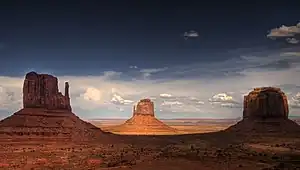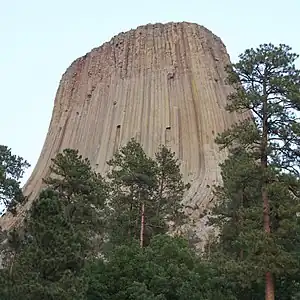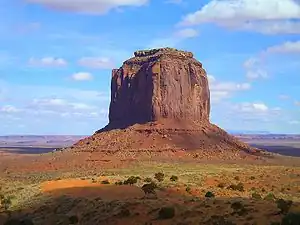Proposal:Tag:natural=butte
| Tag:natural=butte | |
|---|---|
| Proposal status: | Draft (under way) |
| Proposed by: | jeisenbe |
| Tagging: | natural=butte
|
| Applies to: | landform |
| Definition: | A hill with a small flat top surrounded by cliffs |
| Statistics: |
|
| Draft started: | 2019-04-25 |
| RFC start: | 2019-04-26 |
Proposal
natural=butte is used to map a butte: an hill with a flat top surrounded by cliffs. These features are also known as a table, tableland, or tepui. The width of the flat top is less than the relative height of the hill
In a natural=butte the width and length of the flat area on top are both less than the height of the top of the hill above the surrounding terrain. If the flat area is wider than the hill or mountain's height, and is still surrounded by cliffs, use natural=mesa: a mesa is shapped like a low table: a large flat top and short sides, while a butte is more like a tall stool with steep side and a flat top

See butte on Wikipedia and compare with plateau on Wikipedia and mesa on Wikipedia
Rationale
The tag natural=plateau is already in use, but has a much less specific definition. A plateau can be a small, relatively flat highland landform or a term for a large region. The word "tableland" is also used for both small, specific features (i.e. buttes and mesas) and larger elevated regions (i.e. larger plateaus), and therefore can also be ambiguous. Therefore, a separate tag is useful for flat-topped elevated landforms that are surrounded by cliffs.
Most buttes can also be tagged with natural=peak on their highest point, but this new tag will provide a more specific definition and also allows mapping the flat butte summit as an area, when it is clearly defined by steep cliffs.
While "butte" is an American English term, loaned from French, this word is used frequently and with a specific meaning by geologists and geographers. Since such features are common in areas with particular geology and climate, they are not commonly found in England or northern Europe, hence the American term is the most commonly known around the globe.
I have also created a proposal pages for natural=mesa and natural=plateau
Current usage:
Tagging
- As a node: place a node at the center of the landform. In this case also consider using
natural=peakat the summit of the butte.
- As an area: when the top of the butte is surrounded by cliffs, the butte can be mapped as an area with a closed way following the top of the cliffs. Buttes should only be mapped as areas when they have sharp boundaries and where the geometry can be verified by individual mappers.
- See
natural=mesafor similar features with a flat top, but where the height of the hill is less than the width of the flat top. A mesa looks more like a table, not a stool.
- Caution: occasionally a feature will have a name that suggests it is a butte, mesa or tableland, but it lacks a flat top or is not surrounded by cliffs. In this case, another tag my be appropriate. See:
natural=plateaufor other flat landforms,natural=peakthe summit of a hill or mountain, andnatural=ridge.
Applies to
- nodes
- areas
Useful Combinaton
name=*
Rendering
- name label only
See also
natural=plateau- a relatively flat landform or highland areanatural=mesa- a flat tableland surrounded by cliffs. The width of the flat area is greater than its relative height.natural=peak- the summit or secondary peak of a hill, mountain or ridgenatural=ridge- a linear hill or mountain ridgenatural=arete- a knife-edge rocky ridge formed by glaciersnatural=cliff- a vertical or near-vertical slopenatural=valley- a flat area that is surrounded by higher terrain on most sides
Examples
Fajada Butte, New Mexico
* natural=butte
* name = Fajada Butte
Devil's Tower, Wyoming

* natural=butte
* name = Devil's Tower
* alt_name = Bear Lodge Butte
Monument Valley, USA

- Merrick Butte
- In Monument Valley - four corners, southwestern United States
* natural=butte
* name = Merrick Butte
Features/Pages affected
External discussions
See Tagging mailing list from April 2019
Comments
Please comment on the discussion page.